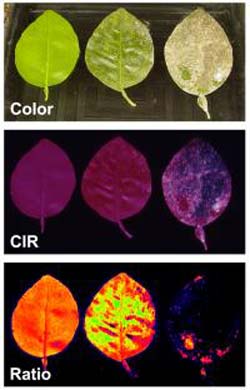Detecting disease in greenhouse plants

Color infrared (CIR) photography is used to detect diseases in greenhouse plants. Credit: Photo by Chris Little<br>
Greenhouses are an integral part of U.S. agriculture. Nearly $200 million of food is produced in domestic greenhouses each year, and the facilities play a vital role in producing seeds and transplantable vegetation. Understanding how to keep greenhouse plants healthy can translate to increased revenue for producers.
Kenneth R. Summy of the University of Texas-Pan American and Christopher R. Little of Kansas State University (Manhattan) led a study examining the stresses of a variety of greenhouse plants. The study, published in the August 2008 issue of HortScience, used color infrared (CIR) photography.
CIR images are divided into wavebands. Ratios are created comparing the NIR wavebands to red wavebands. High NIR and low red values are typical of healthy vegetation because light is being reflected in the proper proportion. Ratios of colors accentuate even slight differences in light reflection, which can indicate disease.
Trifoliate orange, 'Valencia' orange, sour orange, grapefruit, 'Bo' tree, and muskmelon were infested with sooty mold, insects, and pathogens; all are common ailments in greenhouses. Leaves exhibiting a range of symptoms were chosen to compare with healthy leaves of the same species and photographed using CIR.
Certain diseases such as powdery mildew give the leaf surface a powdery finish. Another disease, sooty mold, appears on the leaf as tan, brown, or even black spots. This image analysis allows for detection of these diseases early on. Color ratio was also affected by the age of the leaf in some cases. The ratios for sour orange leaves that were 10 and 35 days old were significantly different. However, there was no difference between 20- and 35-day-old trifoliate orange leaves. This could affect the efficiency of this method when used on whole-plant foliage.
The study also showed a variation in the accumulation patterns of a particular disease on the two trees in the study. “'Valencia' orange leaves were coated very evenly with insect honeydew, whereas honeydew deposits on 'Bo' leaves were very spotty,” reported the researchers. Insect honeydew can contribute to sooty mold growth. As mold infestations increased, the ratio decreased into the unhealthy proportion for all sample plants.
The study points out that this image analysis technology has potential for large-scale use in greenhouses. However, to be most beneficial, the application must be effective in distinguishing the health of plants, cost-effective enough for the purchase of CIR cameras and equipment, and user-friendly so that on-site software processing of data can be completed easily.
Media Contact
All latest news from the category: Life Sciences and Chemistry
Articles and reports from the Life Sciences and chemistry area deal with applied and basic research into modern biology, chemistry and human medicine.
Valuable information can be found on a range of life sciences fields including bacteriology, biochemistry, bionics, bioinformatics, biophysics, biotechnology, genetics, geobotany, human biology, marine biology, microbiology, molecular biology, cellular biology, zoology, bioinorganic chemistry, microchemistry and environmental chemistry.
Newest articles

Silicon Carbide Innovation Alliance to drive industrial-scale semiconductor work
Known for its ability to withstand extreme environments and high voltages, silicon carbide (SiC) is a semiconducting material made up of silicon and carbon atoms arranged into crystals that is…

New SPECT/CT technique shows impressive biomarker identification
…offers increased access for prostate cancer patients. A novel SPECT/CT acquisition method can accurately detect radiopharmaceutical biodistribution in a convenient manner for prostate cancer patients, opening the door for more…

How 3D printers can give robots a soft touch
Soft skin coverings and touch sensors have emerged as a promising feature for robots that are both safer and more intuitive for human interaction, but they are expensive and difficult…





















